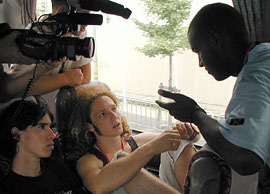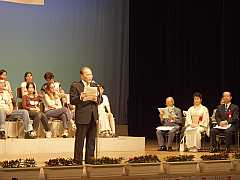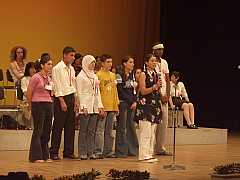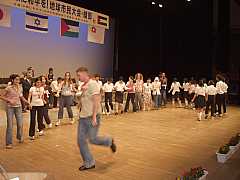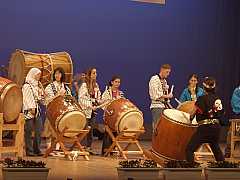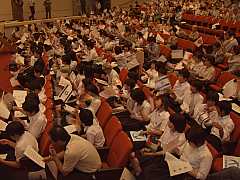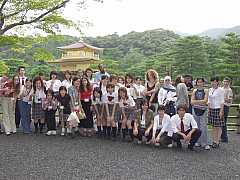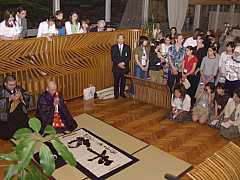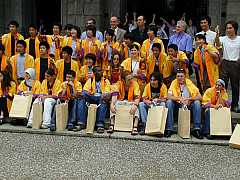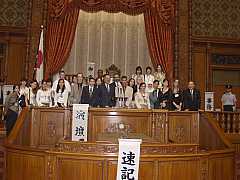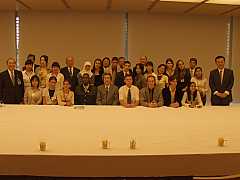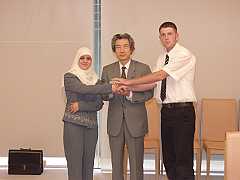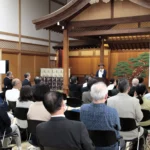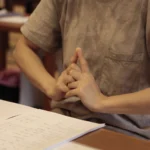By Bill Roberts
Itamar Inabar’s brother died in the Middle East conflict in 1995. Adham Hosni Shahin’s cousin was killed in 2000. Inabar, an 18-year-old Israeli, and Shahin, an 18-year-old Palestinian, have every reason to distrust or even hate each other. But with a little help from the people of Ayabe, the two young men recently had a chance to drum together, dance together and heal together.
Inabar and Shahin were among seven Israelis and seven Palestinians, aged 14 to18, who took part in a program funded and hosted by the City of Ayabe intended to help participants talk, play together and reconcile with each other. The delegation also included one Israeli and one Palestinian adult facilitator.
Over the years there have been other Israeli-Palestinian programs but this one was different from most. Each of the 16 participants has lost at least one family member in the conflict. As the Israeli facilitator, Aaron Barnea, put it: They are the most hurt of the hurt.
“If these people can overcome the hatred, sorrow and sadness they feel over their very personal loss then perhaps it is possible for all Israelis and Palestinians to learn to live together,” said Barnea, whose son was killed in 1999 while serving in the army.
Along with more than a dozen Japanese hosts, the 16-member Middle East delegation visited Ayabe, Kyoto and Tokyo, from July 26 to August 1, 2003. The visitors learned some traditional Japanese arts, including drumming and folk dancing which they later gamely performed in public. They also performed together some of their own native songs and dances.
The kids also had spontaneous and spirited –but civil–debates over some of the more sensitive issues that keep their people from living together in peace.
The one-week program, called the Ayabe Project, was the first of its kind in Japan. It was the idea of Ayabe Mayor Yasuo Shikata, who asked the Peres Center for Peace, in Tel Aviv, to help organize it. The non-profit center turned to the Parents’ Circle-Families Forum, an Israel-based group of bereaved families on both sides working for peace and reconciliation. The facilitators and the parents of most of the participants are forum members.
While attending a mayor’s conference in Jerusalem a few years ago, Shikata got the idea that towns like Ayabe (population 40,000) could play a small but significant role in helping to bring peace to the Middle East. He and others also believe that Japan as a nation, the only country ever devastated by nuclear war, should play a role in the Mideast conflict. Under Shikata’s leadership, Ayabe made a declaration of friendship with Jerusalem three years ago.
Since World War II, Ayabe has been active in the worldwide peace movement, becoming the first city in Japan to declared itself a World Federation city. Ayabe is also the spiritual headquarters of the Oomoto Foundation, a Shinto sect whose mission includes fostering inter-religious dialog. Oomoto provided financial backing and organizational support for Project Ayabe.
But without the people of Ayabe the project would not have happened. Apart from larger contributions by Oomoto and one local company, about 85 percent of the 10 million yen budget came from small, individual donations. Many Ayabe residents also gave their time to teach the kids drumming, dancing, calligraphy, origami and tea ceremony. Some women spent time beforehand tailor-making kimonos for each participant. Eight Ayabe families opened their homes to a pair of houseguests–one Israeli and one Palestinian–for two nights. Hundreds turned out for greetings, receptions and a public performance.
Shikata may be a small-town politician but he had connections that led to meetings between the delegation and the mayor of Kyoto, the governor of Kyoto Prefecture and Prime Minister Koizumi. All the politicians banked on TV following the story–and they were right. Newspaper reporters and TV camera crews followed the group from their arrival at Kansai Airport to their departure from Narita Airport. NHK and others aired reports almost nightly, including several feature stories on the kids with their Ayabe host families. On July 30, the day the delegation met Koizumi, they made the 5 o’clock news.
One reason for all the TV coverage was the novelty of bringing Israeli and Palestinian teenagers into a culture as foreign as Japan to foster a cross-cultural dialog. But the other reason was the poignant stories each teenager told about losing someone in the conflict. For example, one of the Israeli girls lost two brothers; one Palestinian girl lost her father.
Shahin, whose cousin was killed on the first day of the second intifada in September 2000, said the trip changed the negative stereotypes he had of Israelis. “To promote peace and understanding between the two peoples there is a need to start at the beginning with the children. We are the future”
Inabar, who will enter the Israeli army soon in a non-combat role because his family has already lost one son, called the trip “a bridge between the peoples. I can meet with people from the other side…and really get to know them.”
For seven days this summer, it happened that way.
On Day One, the kids eyed each other cautiously despite having spent 20 hours traveling together from Tel Aviv. On Day Two, the facilitators had to assign them to mixed groups for activities. On Day Three they performed for an audience of 1,000. On Day Four, during a long bus trip, there was a hot but nonviolent debate over the status of Jerusalem. On Day Five the facilitators no longer had to tell the kids to break into mixed groups. On Day Six many were hand-in-hand and arm-in-arm. On Day Seven, when they left Japan, they vowed to meet again back at home.
If that happens, it would be the mayor’s dream come true. “We can only provide them this one week opportunity,” an exuberant Shikata said when it was over. “What they do with it back at home is now up to them.”
Meeting back at home will be difficult because of security restrictions and the Israeli government’s effort to build a wall to keep the two peoples apart. At a follow-up meeting in Israel in August, arranged by the Peres Center, at least one Palestinian was unable to attend because her town was under curfew. The sad truth is, it is almost easier for these kids to meet in Japan than it is to meet in Israel or Palestinian territory.
But they may not be easily deterred. Consider this. When they arrived in Tel Aviv at midnight on Aug. 1, the Israelis quickly cleared immigration and picked up their bags. The Palestinians faced security checks that lasted more than 90 minutes.
Although their parents were waiting, the Israeli teenagers insisted on staying until their Palestinian friends cleared security. When the last Palestinian was released, the entire group left the airport together–at 2 A.M.














